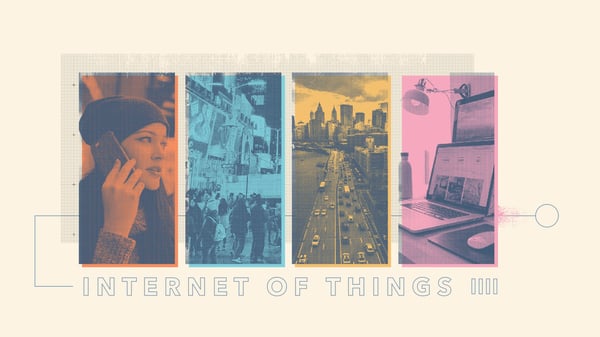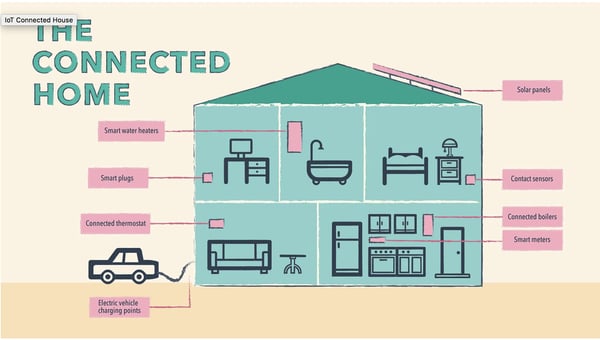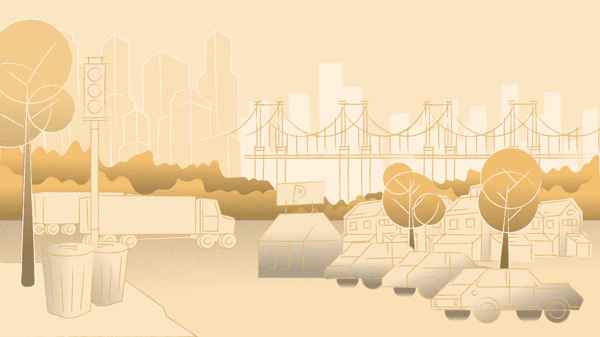Raise your hand if you’ve heard of the Internet of Things (IoT).
I’m guessing most of you have your hand up.
Now, keep your hand raised if you understand how the Internet of Things (IoT) actually works.
If you’re anything like me, you’re probably scanning your brain trying to recall information from an article you read about smart homes two or three years ago … and your arm is probably getting tired. I get it. I'd lower mine, too.
The Internet of Things (IoT) was so elusive to me that I found myself thinking, I know the Internet of Things (IoT) is “here,” but what exactly is it? And how is it impacting my life?
Let’s dive into what IoT is, how it will change the future, and how you can put it to use for your business.
Feel free to jump to a specific section or email this to yourself for later:
Your Apple Watch? That’s part of IoT. Google Home? Yup, that’s an IoT device too. Heck, the entire city of Barcelona is made up of IoT devices. Over the last few years, IoT has quietly taken the world by storm, and it isn’t slowing down anytime soon. In fact, by 2020 there will be 31 billion devices connected to the Internet of Things. To put things into perspective, that’s more than three IoT devices for every person on earth.

IoT Devices
So we have a general idea of what IoT devices are — you’re currently using one to read this article. But phones and computers only make up a small part of IoT. IoT devices include anything that can connect to the internet to send and receive data. And it turns out that almost anything can be connected this way.
There are IoT coffee machines that send out alerts when you’re running low on coffee. IoT connected beds monitor your sleep and adjust the temperature to optimize your sleep patterns. More practical applications of IoT include connected cars that can drive and update themselves and Amazon’s dash buttons that allow customers to reorder everyday products like Tide Pods or razor blades at the touch of a button. The Dash Replenishment Service takes this one step further by allowing the products to automatically reorder themselves when a sensor records that supplies are running low. When extending a market is as easy as slapping a button onto something, it’s not hard to see how companies will start to adopt this new level of connectivity.

Department stores like Macy’s are using in-store iBeacons to send customers targeted rewards and experiences like celebrity meet and greets on Black Friday. Beacons are small, Bluetooth transmitters that connect with corresponding apps installed on connected devices like iPhones or iPads. iBeacon technology allows businesses to have multi-channel communications with their customers — to reach them where they are. It also enables companies to connect with a mass audience. Before iBeacons, individual sales associates would have to tell each customer about a promotion, leaving room for error. With iBeacons, anyone who enters a store with that store’s app can receive an alert.
Let’s say you own a small business, can you still benefit from the Internet of Things? (Spoiler alert: Yes, you totally can). Actually, you may already be benefiting from it. If you use Square to accept payments, you’re using an IoT device. Since 2014, the popular credit card processing company has been connecting and sharing its data via the internet — making it easy for small businesses to receive payments.
According to Forbes, only 18% of small businesses and 13% of mid-sized companies considered IoT a priority in 2015. However, many SMBs are already reaping the benefits of the technology.
Quansett Nurseries, in Westport, Massachusetts, grows microgreens to sell to restaurants year round. Because all of the greens require different microclimates, the nursery set up sensors throughout the greenhouse so farmers could remotely control factors like humidity, temperature, and hydration. The system also automatically adjusts the climate if it senses that one of the elements is off. IoT enables Quansett Nurseries to deliver the best produce possible all year long and reduce waste.
IoT Platforms
The connected devices themselves are only half of the IoT equation though. For these connected devices to even exist, they first need to be created. And to create an IoT device, you need an IoT platform.
IoT platforms allow developers to manage the applications they build as well as store, share, and analyze data. Think about the iOS and Android platforms. Both the iOS and Android platforms allow developers to create apps faster and for less money by providing the underlying technology to solve a specific problem or need. For example, the basic technology behind optimizing connected HVAC systems to lower heating costs is the same regardless of whether a developer is using it for a small apartment or a 50-story office building. However, unlike smartphone apps, developers can choose from hundreds of IoT platforms. Amazon, Google, and IBM are a few of the major platform providers, but countless others offer different solutions for specific needs.
IoT Applications By Industry
All of these IoT devices and platforms around us accomplish a diverse range of tasks that go way beyond just reordering coffee capsules. According to Forbes, 84% of the growing IoT applications will be dominated by a few main industries: Smart Cities (26%), Industrial IoT (24%), Connected Health (20%), and Smart Homes (14%). What does that mean? Let’s find out.

Home and Security
This first category hits close to home … because it’s about your home. A few years ago, 83 million smart home devices shipped to consumers. By 2020, that number will swell to 193 million new devices per year. While seemingly every area of IoT is rapidly expanding, IoT devices within our homes are some of the most noticeable. A world where your house can talk to you and make decisions? Yeah, that’s already a thing. Connected devices currently inside homes include the usual suspects like lights you can control with your smartphone, as well as more advanced options like smart refrigerators that allow you to reorder food from built-in interfaces.
Amazon’s Alexa is currently one of the most popular and well-known smart home devices, with over 10 million new devices shipped in 2017 alone. Alexa can perform a wide variety of tasks like calling an Uber, reading you a recipe, and of course, ordering items instantly from Amazon. Affordable smart devices like Alexa, Google Home, and Apple HomePod help make IoT technology accessible to a broad audience and allow more people to become comfortable with bringing IoT into their personal spaces.
From a home security standpoint, homeowners can install IoT connected doorbells that broadcast live video to their phone when someone approaches the door or smart locks that can be pre-programmed to allow access during certain hours of the day. Say goodbye to ding-dong ditch.
Once again, Amazon is leading the way with their Amazon Key service. Using a compatible smart lock and Amazon’s cloud cam, couriers can scan the barcode on their package to unlock the door and drop it off inside your home. When the door opens, the camera starts recording and then sends a video confirming the delivery to the homeowner. It may sound creepy, but consumers have found this technology to be so useful that Amazon has already rolled it out in 37 cities.
Smart security features aren’t just good for consumers; they’re beneficial to businesses, too. By placing your products directly inside the safety of consumers’ cars or homes, businesses can avoid uncomfortable customer service calls about stolen or damaged packages, and customers get their packages on-time. It’s a win-win.

Energy
Okay, we briefly touched on how smart energy appliances can impact your home. Smart lights, like the Philips Hue bulb, and smart thermostats allow users to remotely control their heating, cooling, and lighting. And while these might seem like just cool, tech gadgets, they can have a significant impact on both homes and businesses.
IoT connected lights can help homeowners save on energy costs by automatically shutting lights off when no one is home. Smart thermostats work similarly by automatically adjusting the temperature to reduce heating and cooling costs.
Consider this: When you walk into your home, you automatically flip on the lights, adjust the temperature, and go about your business. Now, what happens when you go away for the weekend? I’m sure you occasionally forget to adjust your energy settings. So what? Your energy bill may go up a little that month, but it’s nothing you can’t handle. Right?
Now imagine that same scenario taking place in a multi-story office building. The energy cost doesn’t seem so nominal anymore, does it? Smart energy appliances can automatically combat unnecessary energy usage to help increase savings.
And the benefits don’t stop there. IoT devices can collect energy data at a granular level, making it easy for home and business owners to identify issues and plan for the future.
IoT Healthcare
Outside of the home, IoT is beginning to revolutionize the healthcare and health monitoring industries. Hospitals are already able to remotely monitor their patients’ health and collect data using connected medical devices like insulin pumps and heart monitors. This allows doctors to catch early signs of problems and take preventive action.
Within hospitals themselves, connected devices help staff more efficiently manage resources and space. In some cases, that can literally save a life. Sensors on hospital beds that tell when and where beds are open reduce wait times by up to four hours. And monitoring on critical equipment prevents vital hardware from breaking when it is needed most.
Outside of the ER, connected activity trackers like Fitbits enable athletes of all kinds to track their performance and progress. If you’re like me and consider walking the quarter of a mile from your car to the office an athletic activity, you can track and log all of those precious steps. (Ed note: I also walk from my couch to the refrigerator.)
In all seriousness, connected fitness trackers are so helpful even insurance companies are encouraging their customers to wear one. Aetna recently starting giving their employees Apple Watches to keep track of their health and fitness goals, but soon they may be handing them out to all their eligible customers. Why? They hope the watch will encourage users to lead healthier lives, which means fewer insurance claims.
Urban Planning
Imagine a world where there’s always Wi-Fi, city trash cans never overflow, and parking spots are readily available. With the Internet of Things, that world can be a reality. The technology is increasingly influencing urban planning and design to make cities smarter — or wicked smart as we like to say in Boston. The adoption of IoT by smart cities is also increasingly important for a larger portion of the population. Every week, 1.3 million people move into cities. This type of mass migration can put a massive strain on a city’s infrastructure.
By building up information and communication technology, or ICT infrastructure, and sharing data through IoT connected devices, cities can alleviate some of the issues that come with all that growth. In smart cities, sensors embedded in roadways that detect traffic volumes and adjust street lights accordingly reduce commute times. Once you arrive at the office, other sensors send the location of all nearby available parking spaces directly to your GPS.
Smart cities are pristine because smart garbage cans and dumpsters automatically compact the trash or send alerts to waste management officials to be emptied. The structural integrity of bridges, tunnels, and buildings can be monitored in real time to avoid catastrophes.
All this technology is closer than you think. London, New York, Philadelphia, and Kansas City are just a few of the many cities who have appointed Chief Technology Officers to pursue smart city technology. San Diego is already installing 3,200 roadway sensors and may add an additional 3,000 to help manage traffic and parking. Connected trashcans are present in numerous cities including Boston and Pasadena. We may still be waiting for flying cars, but free Wifi in Seoul, Tel Aviv, and Helsinki is a pretty cool perk while we wait.

Transportation
Smart roads. Smart parking. Sounds good, right? Now imagine driving on those smart roads and parking in those smart spots in a new smart car. In two years, experts project 250 million smart cars will be on the roads. 10 million of those cars will drive themselves. And that’s only the start.
Remember those little electronic speed boats you played with as a kid? Imagine if those were life-size and filled with millions of dollars in consumer goods and commodities. Rolls-Royce is currently working on remote-controlled drone ships operated from a central hub. They predict the first fully autonomous ship will set sail by 2020.
And who can forget Amazon’s infamous drone delivery service? Amazon’s Prime Air promises to deliver small packages in 30 minutes or less via autonomous aerial vehicles. With the Internet of Things, the drone can use connected sensors to track potential hazards both on the ground and in flight. While this delivery method has only been tested on a small scale in England, it has the potential to reach millions of consumers — allowing users to safely ship and receive products.
Now you may be thinking, this all sounds cool, but is it really necessary? Smart transportation doesn’t just include self-driving cars and drones, sensors inside airplanes can alert maintenance crews of any issues, GPS apps can help safely navigate you to your destination, and IoT car sharing programs allow you to access a vehicle when you need one. IoT is revolutionizing the way humans and physical goods get from point A to B.
Manufacturing
If smart transportation is revolutionizing the way goods get to customers, smart manufacturing is revolutionizing how those goods are produced and tracked. Industrial IoT, or IIoT, while not as attention-grabbing as smart lights and cars, is one of the most successful applications of IoT.
According to a TATA Consultancy Survey and Business Insider, “Manufacturers utilizing IoT solutions in 2014 saw an average 28.5% increase in revenues between 2013 and 2014.”
That’s pretty substantial growth.
IIoT allows business to quickly and precisely track their merchandise. According to Forbes, “New RFID and GPS sensors can track products ‘from floor to store.’” Retailers can now collect data on how long a package was in transit, the condition it arrived in, and even the temperature it was stored at — making it easier for companies to deliver their products on-time and in perfect condition.
And not only can smart manufacturing track shipments, but it can also track inventory. All of the data it collects makes it easier to forecast manufacturing trends — no more missed deadlines, no more missing packages.
How the Internet of Things (IoT) is Changing Business
For Customers
So far, the future is looking pretty exciting thanks to the Internet of Things. Cities are cleaner and more efficient, you’re saving money on your electric bill, and you never run out of household essentials. But what does this all mean for business owners? We’ll get to that in a minute, but first, let’s talk about what the adoption of IoT means for customers.
The greatest thing IoT will change for consumers is their experience with customer service representatives. Companies, instead of customers, will start initiating customer service interactions, and these exchanges will often begin before a problem has even occurred. Essentially, customer service will switch from a reactive to a preventative model.
For example, sensors in Michelin truck tires allow the company to monitor the wear and tear of the tire tread and air pressure and alert transportation companies to change their tires before a dangerous blowout occurs.
When customers do get in touch with companies to solve a problem, IoT will also allow customer service representatives to enter the interaction with a trove of information. Instead of describing your problem, you’ll be able to skip right to solving it thanks to the information sent to the manufacturer from your connected device. With this data, customer service will be ready to quickly identify the source of the problem and walk you through a solution or ship out a replacement.
IoT’s impact on customer service extends far beyond just simple problem-solving. For example, Diageo used IoT whiskey bottles to allow people to send personalized messages to their dads on Father’s Day.
In 2013, Disney launched one of the most impressive IoT use cases with their MyMagicPlus Program. With this program, the park now provides a connected MagicBand bracelet to every guest. Once guests enter the park, their connected bracelet lets Disney guide them towards attractions with shorter lines, find them if they need help, unlock their hotel room, and make purchases. With access to more data, there are even more possibilities for enhancing the MagicBands. Disney characters could use data from the bands to greet guests by name, guests who get stuck in long lines could automatically be given food and drink vouchers, and photos taken by connected cameras could be sent to guests every day. In a world where IoT is increasingly integrated into consumer experiences, this level of service will become the new normal.
This doesn’t need to be intimidating. SMBs can start experimenting with low-cost, low-risk Internet of Things implementation to determine the best use of the technology for their business. IoT can be as simple as attaching an external sensor to a package to track its shipment or setting aside a small portion of funds to invest in experiments with IoT. Dedicate a small, separate team to exploring new types of innovation. By keeping this team separate from day-to-day operations, they will be able to focus on using IoT to solve big-picture problems instead of day-to-day ones. Companies that use IoT to reduce friction in their customer experience will see the greatest benefits as adoption grows.
For Business Operations and Supply Chain
Internally, connected devices within companies will improve operational efficiency by allowing management to identify unprofitable or unproductive processes and remove or enhance them. By converting the physical world into digital data, IoT allows every step to be measured and managed. In the short term, this may result in staff reductions within less productive areas or staff increases to support the implementation of IoT into the business.
Once IoT is integrated into a business's day-to-day process, it can become a powerful enabler for monitoring and improving operations. Manual data collection is slow and inefficient, but connected devices allow information to be continuously gathered and analyzed which enables employees to focus on more strategic, impactful tasks. In one example, Shimane Fujitsu, a leading manufacturer of notebooks and tablets, used IoT tracking technology to reduce lead times by 20% and reduce shipping costs by 30%. This optimization freed up their employees to work on new projects.
Opportunity for Alternative Business Models
Widespread adoption of the Internet of Things will also create entirely new fields of opportunity for savvy companies. John Rossman, a former Amazon executive, discusses several options in his book The Amazon Way on IoT. Based on what he observed, we think there are three major options for small- to medium-size businesses to adjust their current business model with IoT. These include building a platform business, switching to an outcome-based model, or using data as your business.
Some, but not all, businesses will be able to create their own platforms using IoT. Although this option is not right for every company, organizations with widespread reach and the infrastructure to support an IoT platform can spin off their investment into an entirely new business. Amazon’s Alexa platform is one of the strongest examples of this approach with over 15,000 third-party skills already available.
With new IoT-collected data, some businesses may want to switch to an outcome-based model. For example, Progressive introduced Progressive Snapshot, a program that uses a detachable sensor connected to clients’ vehicles to track their driving and adjust their insurance rate accordingly. Customers are increasingly becoming used to paying for results instead of a flat rate for a product or service, and it’s not hard to see why. For Progressive customers, the company’s experiment with IoT has generated over $600 million in insurance discounts.
Every implementation of IoT produces volumes of information and, just like user data from social networks, IoT collected data is already creating new markets for sellers and buyers. Companies who can successfully manage customer data from their IoT devices can sell that information to other marketers and research organizations. According to Rossman, 10% of organizations will soon have entire departments dedicated to selling and trading IoT collected user data. And that’s got some people concerned...
IoT Security
Okay, now we’ve discovered the true hidden gem of the Internet of Things: data. Just imagine what marketers and businesses could do with all this new data.
But while IoT is extremely useful, it doesn’t come without baggage. Data security in the age of IoT is more crucial than ever. While the mountain of consumer data is useful for businesses and governments looking to help their customers and citizens, it’s also useful for malicious groups seeking to disrupt the system. In 2015, hackers used an unprecedented cyber attack to shut down the power grid in Western Ukraine, which left over 230,000 people without power or heat. As more infrastructure and consumer goods become connected to the internet, they also become vulnerable to these kinds of cyber attacks.
According to a report from the FTC, fewer than 10,000 smart homes can produce over 150,000,000 data points … in a single day. Those points represent more opportunities for hackers to enter a system and steal customer information. In the wake of disastrous incidents like the Equifax breach in 2017, companies have scrambled to maintain consumer confidence by adding additional protections and security measures. However, the rapid pace of IoT evolution and implementation makes it hard to keep up.
Currently, no foolproof solution exists for securing IoT devices. Government regulators are still catching up to the technology, which means some IoT products are not entirely secured. For now, that means companies and consumers need to make security a priority of their own. For consumers, the benefits of more secure IoT devices are fairly obvious, but businesses that prioritize IoT security will likely benefit in the long term by avoiding damaging lawsuits and public relations disasters. As a first step, the Department of Justice recommends that IoT devices implement secure password practices and that users keep their devices’ firmware updated to help protect against cyber attacks.
Conclusion
With the promise of 31 billion connected devices by 2020, it’s safe to say that the Internet of Things has arrived, and it’s here to stay. And with the rise of IoT, comes an onslaught of data. Connected communities will have the luxury of total convenience and personalization, as well as access to massive amounts of data. This data will allow businesses and consumers to proactively engage instead of react.
While this data will have a significant impact on marketing as we know it, it will also require unprecedented amounts of security. Without the proper protection in place, individuals or entire infrastructures could be at risk.
IoT and the data it collects will change life as we know it, but the technology alone will not help businesses. Companies that hope to flourish must use IoT to up-level the customer experience, increase operational effectiveness, and improve how they grow their businesses.
No comments:
Post a Comment